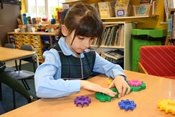Developing numeracy – The Art of giving the Same Name to Different Things? by Frances Mwale, Farlington Prep Headmistress
06 May 2015
 The French mathematician, Henri Poincare, described mathematics, unlike poetry, as “the art of giving the same name to different things”. I like this definition as, rather than being all about right or wrong answers, it suggests that creativity, relationships and rich language, are integral to the subject.
The French mathematician, Henri Poincare, described mathematics, unlike poetry, as “the art of giving the same name to different things”. I like this definition as, rather than being all about right or wrong answers, it suggests that creativity, relationships and rich language, are integral to the subject.
Nottingham and Oxford Universities were recently awarded over £2million towards solving the world’s 6 unsolved mathematical problems, yet press and Government releases inform us that the UK is falling behind many other countries. PISA results (Programme for International Student Assessment) show that our 15-year-olds lag behind the Far East and others in terms of what they attain in tests.
A public admission at being terrible at reading or writing is pretty unthinkable, yet it seems acceptable for adults to say, ‘I was never any good at maths’ as a way of excusing a lack of progress, for them or for their children. In school we find children who really love maths: they enjoy problem solving, finding solutions and for some, not having to write loads!
Mathematics possibly conjures up for you thoughts of endless algorithms, but it also encompasses mathematical thinking, where patterns and relationships are key. For those who feel inept at maths, thorny topics most feared are usually algebra, fractions and division, because we fail to see the relationships between numbers: denominator compared to numerator, for example.
Just learning rules to manipulate number is not enough: a literacy equivalent would be reading letter e, knowing the sound it makes but then not being able to use it in different words. Making decisions about why and when to use methods, even devise new ones, is what gives mathematics its intrinsic appeal.
No subject is in complete isolation. In order to understand mathematics, we use the language of notation and recognise its symbols. Young learners have to equate a number symbol, say 5, with 5 ducks, or 5p or 5 pupils. They have to take on board a complete vocabulary – the language of mathematics – beginning with comparisons such as big and small, difference between, larger than. Working with 2 ½ year olds, I was fascinated that they could identify biggest and smallest, but could not place 3 frogs in ascending size order. Just as we crawl before we walk, we reverse letters and numbers before we finally master their formation, so in mathematics, we move forwards at age-appropriate stages. Instead of moving on to ‘harder’ concepts, we go deeper and wider with mathematical learning.
Being good at maths is often equated with being quick; that mental maths and correct answers are the only success indicators. But to push back the boundaries of mathematical thinking, we have to see problems in a new light and ask different questions. With developed teaching methods, greater application, less rote learning or endless columns of sums, why are we less good at manipulating number in our heads? As a child, I would visit local shops to spend my pocket money, working out change and handing over the right coins. I measured and made clothes for my dolls, weighed out ingredients for cooking and played games that required adding and subtracting: there were always valid reasons for practising. Classroom challenges really motivate when children make the discoveries: working out primes, inventing sequences, deciphering codes. Ideas that seem neat and clever, can be so rewarding.
My master’s research looked into the use of language in mathematics. It began with the notion that we use internal language in our heads when thinking. Young children babble aloud about everything they do and then gradually that commentary changes to silent thinking. Internalising the ‘talk’ can be difficult and so my study encouraged speaking to support all areas of mathematical learning. We should be asking challenging questions of young children: replacing ‘Look at the pretty rabbit’ with ‘How many can you see? Are they all the same size? How fast can they run?’ As parents and teachers, we need to grab every opportunity to bring meaning to the language of mathematics.
So, how best can you support your child in their mathematical learning? I would suggest by getting creative with them. Do not just provide a diet of sums, or drill and practise computer games, but allow them to enjoy number, to use mathematics as a regular part of their daily activities, to experience reaching wrong answers then find out why, boosted by the joy of discovering new possibilities. Make thinking as concrete as possible, linking the abstract mysteries of symbols and digits, to bricks, counters, sweets –anything that can be handled and moved around, showing patterns and differences. Most importantly, make full use of mathematical language to promote deeper thinking.
Frances Mwale, Prep Headmistress, Farlington School
Farlington School, West Sussex